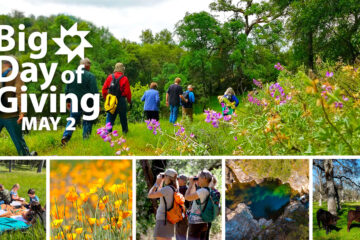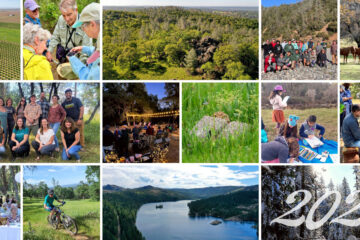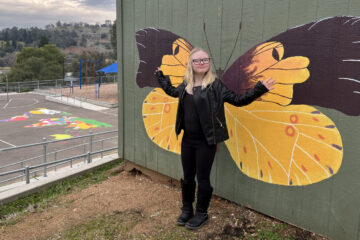Over the past several years we’ve been experimenting with numerous designs for making artificial nests to help increase the Burrowing Owl population on our Swainsons Grassland Preserve and Doty Ravine Preserve, both in the Lincoln area. We’ve had some successes and we’ve learned some things along the way helping to improve our designs.
Land Manager Justin Wages first saw Burrowing owls at our Swainsons Preserve in 2007 when he was a PLT volunteer. But, we know these cute little owls have been there longer than that. Cattle grazer and long-time resident Greg Lawley said he’s seen the owls for about the past 30 years.
Introduction to Burrowing Owls:
If you aren’t familiar with them, Burrowing owls are quite different from other owls. The Burrowing Owl Conservation Network describes them as “small owls that live in dry, open areas where grasslands, rangelands, agricultural lands, deserts and scrublands are found. These small owls are less than 12 inches tall, have long legs and a short tail, are mostly brown with numerous white or tan spots, and have white eyebrows just above bright yellow eyes. As their name implies, burrowing owls actually make their homes underground. As opposed to the Florida Burrowing Owl that may dig their own burrows, Western Burrowing owls rely on the abandoned burrows of mammals like ground squirrels, prairie dogs, badgers, coyotes, and foxes.”
They eat mostly insects, such as grasshoppers and beetles, but will also dine on voles and other small rodents. They have been known to put cow dung near their burrows which attracts dung beetles, a favorite delicacy. But the cow dung may also serve another purpose in aiding to mask their scent to confuse predators. They like to nest in open fields and grasslands, and generally stay away from riparian and wooded areas where they are more subject to predation. They need plenty of forage and nesting areas in safe locations. In general, Burrowing owls in our area pick a spot to spend the winter, but leave in the spring to find a nesting location. Our Swainsons Preserve is a little unique in that there is a resident pair who is there year round. On Doty Ravine Preserve, just a few miles away, the owls only stay during the winter.
When ready, the baby owls leave the nest to find more burrows. Being social creatures, they often don’t travel far. Placer Land Trust is adding more burrows in an effort to keep them on our preserves by attempting to form colonies to increase their population.
Artificial Burrow Designs:
The idea for installing artificial nests is due to the limitations of ground squirrel holes. Squirrels usually won’t go into open fields to dig holes because it puts them at higher risk to become someone’s dinner. The squirrel holes on our Swainsons and Doty Preserves are found along fence lines and corrals where the squirrels have a little more protection from predators. But this isn’t conducive to the owls, who would prefer to be out in the open, so we focus on the middle of the field to expand the habitat.
Burrow Design 1:
Our first attempt at installing artificial burrows was in summer 2011, and we partnered with the Defenders of Wildlife and the Burrowing Owl Conservation Network (BOCN). We built and installed quite a few, with some at both Swainsons and Doty Preserves. The materials were donated by BOCN and consisted of: 55-gallon plastic drums cut in half to make the nest chamber and 4 inch drain tubing pipe. The tubing provided the entry tunnel for the owls to crawl into to get to the drum. There were two entries for each nest. Holes were dug and the drums and pipe were buried in dirt leaving just the entrance exposed. The open end of the pipe was attached to a cinder block to stabilize it. The nests were placed in pairs facing each other with about 10-15 feet separating the entrances, with a perch placed in the middle. This provided four entry ways the owls could quickly escape into if a predator was detected. Buckets were also cut and placed on top of the drum as a way to see inside the nest, creating a viewing chamber.
Results: We had some success with this design. Within days the owls moved into the new artificial burrows. But during the rainy season the nests flooded and the owls left to find new, dry burrows. We discovered this in second year during the wet season. Even though the nests were installed on high points, the soil on the preserves is mostly clay which doesn’t drain well. Since we had to dig the hole to install the plastic drums and tubing, the rain water built up in those disturbed areas and didn’t drain. We also had some issues with the cows walking on and laying on the exposed dirt, crushing the pipes and nests underneath. The viewing buckets also had leakage letting water into the nests. However, some of these nests are still in use. In 2012, after the soil re-compacted, we had a scout troop assist us in fixing the pipes on the salvageable nests, but many were destroyed beyond repair. Owls are still hanging out in the tubes to escape predators, which are mainly hawks, rattle snakes, coyotes, bobcats, and feral cats. This design would work well in areas without cattle and in different soil.
Burrow Design 2:
In 2013, we tried another nest design, which we have nicknamed our “bomb proof” burrowing owl nest. To prevent cow damage, this one consists of a cemented in cinder block chamber placed in a dug out area, the same drain tube pipe as the previous design, but uses a gravel French drain system on a slope. It’s covered in dirt, and there is gravel over the tubes to help prevent the cows from walking on and crushing it. This one is at our Doty Ravine Preserve.
Results: It has been used but there have been no sightings of babies. However, we have never seen babies at Doty, which appears to just be used as an over-wintering location. This design withstands the cows and flooding issues, however it was labor intensive and costly. It took two days just to build this one nest (with our current design we can install seven new burrows in one day.)
Burrow Design 3:
In 2014, we partnered with Westervelt Ecological Services on riparian project which included adding new burrows. This project took place at both our Swainsons and Doty Preserves, and utilized help from the AmeriCorps NCCC crew that was working with us at that time. We used large cement pipes (10 to 12 feet long by 6 inches tall) cut in half lengthwise and placed in a “V” shape. Rather than digging holes and placing the burrows in-ground, this design is placed on the ground and covered with dirt. The viewing chamber from design one was eliminated. These two changes were tried in an effort to reduce the flooding issues we had in the first design. We installed four of this design – one at Doty and three at Swainsons. The three at Swainsons were installed on a section of the preserve across the highway from the other burrows, in an effort to entice the owls to expand their territory.
Results: The owls starting using the nest at Doty the next year, but we have not seen any using the nests at Swainsons. One problem is skunks, which move into the nests and then the owls can’t use them because they are already inhabited. We’ve started installing fences around the burrow area to keep cattle out, and also in an attempt to keep skunks and other predators away from the nests. Even with those changes, the nests at Swainsons are sitting there unused, and we’re not sure why? We were hoping they’d cross over the highway and expand their territory, but so far they haven’t moved to that side of the preserve. We don’t know if it’s the location or if that side of the preserve isn’t flat enough to entice them to move there. The downside to this design is the expense and it’s not volunteer friendly. The tubes weigh about 500 pounds and require a bobcat tractor or backhoe to move and install them, plus a heavy duty saw was needed to cut them in half.
Burrow Design 4:
In spring of 2016, we started using a new design which a different AmeriCorps team helped us install. We used smaller clay sewer pipe, four inches in diameter, donated from Gladding, McBean in Lincoln. These smaller pipes didn’t require cutting and don’t weigh as much. We also got elbow bend pipes that were used for the tunnel leading to the nest. For the nest itself we used a 55-gallon steel barrel cut in half, which was donated by Side Hill Citrus. We started with two nests, one at Doty and one at Swainsons. At Swainsons, we’re trying to create a “compound” by adding the new burrows near the already existing burrows. We placed this newly designed burrow in the same area as the one we installed using design 1, and have the area fenced off to keep cows (and hopefully skunks) out of the nests. This design is also above ground, but we dug small depressions in the soil so that the pipe would lay flat without rolling. Then it was covered with 10 inches of dirt to help hold it in place as well as provide insulation. Rock will be added later on top and around the pipes and barrel for extra protection and insulation. To reach the nest, the owls have to enter the open end of the pipe and maneuver through nine feet of tunnel. We also eliminated the viewing buckets from this design.
Results: We are pleased to report we had success with this new nest design at both locations. Baby owls were spotted in the nest at Swainsons in the late spring and summer. We are thrilled! In fact, as soon as the fledglings left the nest we arranged to go back and install more of this design. In late August, along with help from several volunteers, including a few 5th grade girls, we installed four more nests in the “compound”. They will need to be covered with dirt and rock, but the pipe is laid out and ready to for new occupants. What we like about this design, other than the fact that the owls are using it, is it’s much less expensive to install. The clay pipe is cheaper than other materials we’ve tried, durable and long lasting. This design is easy to build, it’s volunteer and kid friendly, and if livestock wasn’t on the property the rock could be eliminated. We use rock as extra protection against livestock damage, and it makes it more difficult for predators. This design also doesn’t appear to need maintenance. It’s easy to replace the steel barrels if needed. What we also like is the clay pipe from Gladding, McBean is we’re using clay pipe in the same general area where it was taken from to be manufactured into pipe. The Gladding, McBean plant is only a couple miles from the Swainsons Preserve. We will be monitoring these new nests and if all goes well, more installations of Design 4 artificial burrow will follow.
We’d like to thank Pamela Flick with Defenders of Wildlife and Scott Artis with Burrowing Owl Conservation Network for being the catalysts that got us starting using artificial nests. Without their help early on, we may not have gotten this far.
We also want to give big thanks to Auburn resident Dennis Cavallo, who has been a major contributor to this program. Dennis has volunteered countless hours over the past several years monitoring the nests to see if they’re being used, taking pictures and video which he sends us, providing support to keep things moving along, donating funding for the project, and keeping PLT Land Manager, Justin Wages, in check!
Special thanks to 10 year old Juliana Meadows-Yaw for learning about burrowing owls and becoming an advocate, for holding bake sales to raise money to install a new nest, and for bringing her friends along to help with the project.
We have also recently picked up some great sponsors for this program:
- Gladding, McBean in Lincoln (for donating clay pipe)
- Side Hill Citrus in Lincoln (for donating barrels)
- Placer County (for donating barrels)
- Teichert (for donating rock)
We appreciate your support!


